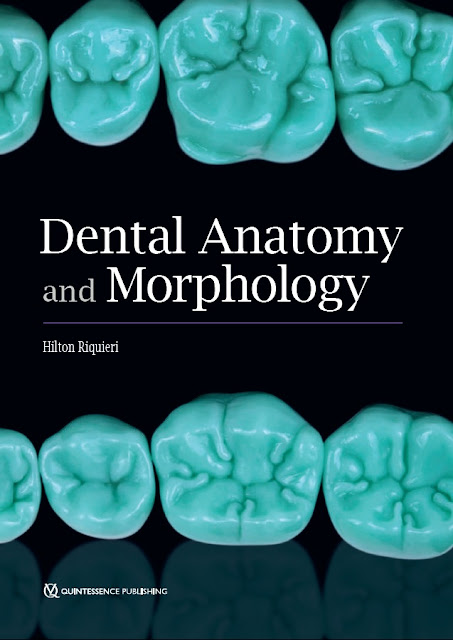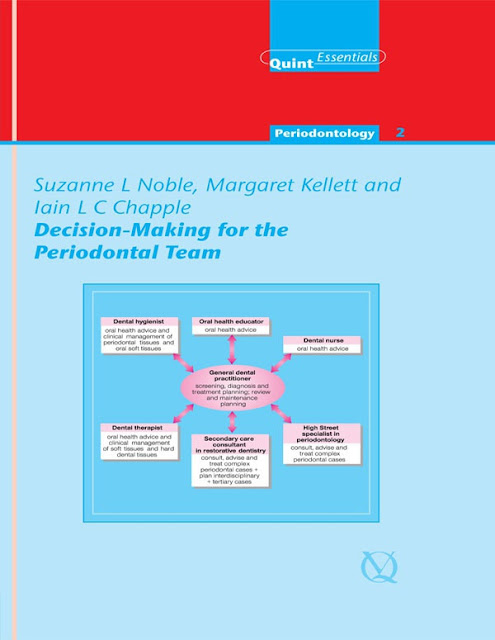Decision Making for the Periodontal Team PDF Free Download (Direct Link)
High-quality dental patient management demands an appropriately skilled team. It is the general dental practitioner’s responsibility to co-ordinate the team and to take overall responsibility as the team leader. Your team provides all the specialties necessary to achieve a stable, functional, aesthetic masticatory unit, which not only encompasses the management of periodontal disease, but integrates a treatment plan the patient can maintain.
Contents
Chapter 01. The Periodontal Team
Chapter 02. Medicolegal Aspects of Employing Professionals Complementary to Dentistry
Chapter 03. Working Together
Chapter 04. Selecting Surgery Equipment for the Dental Hygienist
Chapter 05. Prevention of Oral Disease I: Periodontal Disease
Chapter 06. Prevention of Oral Disease II: Diseases of the Hard Tissues
Chapter 07. Management of Periodontal Diseases
Chapter 08. Orthodontics and Periodontal Health
Chapter 09. Occlusion of Relation to Periodontal Disease
Chapter 10. Periodontal-Restorative Interface
Chapter 1
The Periodontal Team
Aim
This chapter aims to provide the general dental practitioner (GDP) with an insight into the development and role of professionals complementary to dentistry within the context of the management of periodontal diseases.
Outcome
As a result of reading this chapter the practitioner should have an understanding of how the periodontal team has evolved and the legally permitted duties of dental hygienists and dental therapists.
Introduction
It is in the primary care setting that the vast majority of periodontal disease is diagnosed and managed. The team involved in patient care may be small, involving only the dentist, dental hygienist and dental nurse. Conversely, the team may work together in a large polyclinic where periodontal care is one of many specialist dental services offered. In such situations the periodontal specialist will be available for the diagnosis and management of the more complex cases.
In its broadest sense, the dental team reaches beyond the high street surgery to include the secondary care services in hospital periodontal departments where the consultant in restorative dentistry and his or her team will offer advice and, where appropriate, treatment of referred cases.
In order to obtain the most appropriate care for an individual patient the GDP will refer the patient to other team members to utilise their skills, knowledge and experience to achieve the desired treatment outcomes. Rather than this referral process being considered as a hierarchical model, it is suggested that it be considered in a circular form with the GDP at the centre. It is the GDP with whom the patient is registered and it is the GDP to whom the patient returns for continuing care (Fig 1-1). The role of the GDP is an infinite one! The other team members have important skills to offer, but their roles are finite ones, clearly defined by the practitioner’s referral request or treatment plan.
Fig 1-1 Members of the periodontal team.
By co-ordinating the referral process the practitioner plays the key role in consolidating the treatment and ensuring that the patient is informed of the reasons behind the referral. The role of the practitioner as the team leader is explored further in Chapter 3, but by way of introduction to “working together” this chapter will focus on the evolution of the professionals complementary to dentistry and the skills these team members have to offer.
The Dental Hygienist
Although dental hygienists were first trained in the United States in 1913, there was no formal training in the UK until 1943, in the Royal Air Force. During the next 20–30 years schools of dental hygiene were founded and attached to dental schools, but they trained relatively few hygienists compared to dentists. Enrolment with the General Dental Council (GDC) became mandatory in 1957.
The original concepts of patient education and prevention of periodontal diseases remain the linchpin of the dental hygienist’s role, but the range of permitted duties has expanded in recent years in line with the current concepts of team management for patients with oral diseases. Dually qualified dental hygienists/therapists now receive education to diploma and degree levels in universities alongside undergraduate dental students. This enhances the periodontal team concept within the workplace.
The changing patterns of oral disease and the increasing public awareness and demand for oral health was the driver behind the Nuffield Inquiry into Education and Training of Personnel Auxiliary to Dentistry in 1993. This extensive inquiry examined the role of dental auxiliary personnel, and stimulated widespread debate on a number of key issues surrounding the development of the dental team. Following this the GDC set up the Dental Auxiliaries Review Group (DARG), to prepare appropriate recommendations in relation to all classes of dental auxiliary. The committee reported in 1998, setting out proposals on permitted duties, entry requirements and registration. It was also recommended that the team concept for future practice should be promoted through the training of dentists and dental auxiliaries in close association with each other.
Subsequently, in 1999, the GDC announced a new era for professionals complementary to dentistry. The council supported statutory registration of all members of the dental team and the widening of clinical roles after appropriate education and training. Although the term dental hygienist remained protected, as it was a role with which the general public was familiar, the dental hygienist became incorporated into a wider group subsequently named Professionals Complementary to Dentistry (PCD). The GDC emphasised that entry to the register would be on the basis of appropriate education and that each PCD should practise only under the delegated authority of a registered dentist.
It was the expressed intention of the GDC that all PCDs should continue to work within the dental team within which the dentist would remain responsible for diagnosis, treatment planning and the quality control of the treatment provided (Fig 1-2).
Fig 1-2 The team and team leader.
Legally Permitted Duties
Until such time as the GDC is able to register all PCDs, dental hygienists and dental therapists may practise dentistry to the extent of the Dentists Act 1984 and the 1986 Dental Auxiliaries Regulations, with amendments in 1991 and 2002. It is an offence to practise outside these limits.
They are permitted to work “under the direction of a registered dentist”. This implies that the dentist has examined the patient and indicated in writing the course of treatment to be provided. The dentist need not necessarily be present on the premises at the time the hygienist or therapist is carrying out the treatment. This legislation formed part of the 1991 amendment to permit hygienists to carry out domiciliary visits.
The supervisory role of the dentist varies in differing clinical situations and it is the dentist’s responsibility to be aware of these parameters. In the case of treatment of a patient under conscious sedation by a hygienist or therapist, the dentist must be in the surgery with the patient throughout treatment. Whilst inferior dental nerve blocks are being administered the dentist must be on the premises but not necessarily in the room. With the introduction of expanded duties from 2002, many practitioners will be involved in workplace post-qualification training for additional skills for hygienists and therapists, and the recommendations are for close personal supervision of a designated number of procedures.
Dental hygienists are permitted to carry out the following kinds of dental work:
- Cleaning and polishing teeth.
- Scaling teeth (i.e. the removal of deposits, accretions and stains from those parts of the surfaces of the teeth which are exposed or which are directly beneath the free margins of the gums, including the application of appropriate medicaments).
- The application to the teeth of such prophylactic materials as the GDC may from time to time determine.
- Giving advice within the meaning of section 37(1) of the Dentists Act 1984 such as may be necessary for the proper performance of the dental work prescribed.
- The taking of dental radiographs.
- The administration of local infiltration and inferior dental nerve block analgesia for the purpose of scaling or root debridement.
- The taking of impressions for diagnostic purposes.
- The emergency placement of temporary dressings and replacement of crowns with temporary cement.
- The treatment of patients under conscious sedation.
Depending upon the date of primary qualification, there may be additional skills obtained and certified by course attendance and workplace supervision. In clinical practice the dental hygienist’s skills include:
- The removal of supra- and subgingival calculus.
- Closed root surface debridement (RSD).
- Appropriate oral hygiene advice.
- The application of local delivery antimicrobial agents as an adjunct in periodontal therapy (under the Medicines Act 1968 the dentist must prescribe the drug to be used).
- Management of dentinal hypersensitivity with appropriate medicaments.
- Prevention of dental caries by the application of topical fluoride.
- Fissure sealing (the use of filled resins in minimally prepared cavities is not permitted).
- Polishing dental restorations.
Dental therapists may carry out all the duties listed for dental hygienists with the addition of:
- Extraction of deciduous teeth.
- Simple fillings.
- Pulp therapy to deciduous teeth.
- The placement of prefabricated crowns on deciduous teeth.
Permitted Duties of Dental Hygienists and Dental Therapists since the 1986 Dental Auxiliaries Regulations
Local anaesthesia
Local infiltration analgesia
Dental hygienists who hold the Diploma in Dental Hygiene awarded after 1992, or dental therapists who hold the Diploma in Dental Therapy (formerly the Certificate of Proficiency) may carry out scaling under local infiltration analgesia. This competency was included in the hygienists’ core curriculum from 1992 onwards. Therefore hygienists qualifying after that date…
Author
Suzanne L. Noble
Margaret Kellett
Prof. Iain L. C. Chapple PhD, BDS, FDSRCPS, FDSRCS, CCST (Rest Dent)
United Kingdom, Birmingham
- Name of Book: Decision Making for the Periodontal Team
- Format: pdf
- Categories: Periodontics
- Writer(s): Lain LC chapple, Margaret Kellett, Suzanne L. Noble
- Publisher: Quintessence Publishing Company
- File Size: 6mb
Dental Anatomy and Morphology PDF Free Download
Decision Making for the Periodontal Team PDF Free Download
Alright, now in this part of the article, you will be able to access the free download of Decision Making for the Periodontal Team using our direct links mentioned at the end of this article. We have uploaded a genuine PDF ebook copy of this book to our online file repository so that you can enjoy a blazing-fast and safe downloading experience.













![An Outline of Oral Surgery Part 2 by H.C. Killey (A Dental Practitioner Handbook) PDF Free Download [Direct Link]](https://www.cmecde.com/wp-content/uploads/2024/01/Download-An-Outline-of-Oral-Surgery-Part-2-by-H.C.-Killey-A-Dental-Practitioner-Handbook-PDF-Free-Direct-Link.jpg)
![Treatment Options Before and After Edentulism: Tooth Supported Overdentures 2023 Edition PDF Free Download [Google Drive]](https://www.cmecde.com/wp-content/uploads/2024/01/Treatment-Options-Before-and-After-Edentulism-Tooth-Supported-Overdentures-2023-Edition-PDF-Free.jpg)



![Download Oral and Maxillofacial Surgery Lars Andersson PDF Free [Direct Link]](https://www.cmecde.com/wp-content/uploads/2023/08/Download-Oral-and-Maxillofacial-Surgery-Lars-Andersson-PDF-Free-Direct-Link-100x70.jpg)
